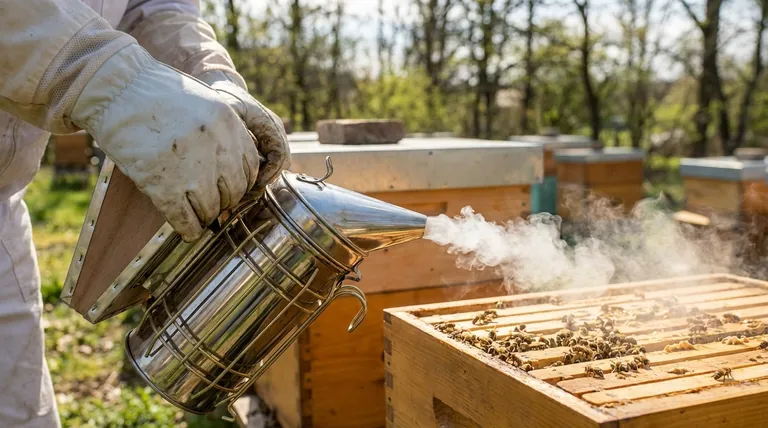Yes, smoke can be used to manage bees, but it is a critical misunderstanding to think it will get rid of them. Smoke is a tool used by professional beekeepers to temporarily calm a hive for inspection, not to force a colony to leave permanently. Using smoke incorrectly will not solve your problem and can make the situation significantly more dangerous.
The core principle to understand is that smoke masks bee communication and triggers a temporary survival response. It does not act as a repellent or a removal agent; it is a short-term management tool that requires precise application to be effective and safe.

How Smoke Actually Affects Bees
To use any tool correctly, you must first understand its function. Smoke doesn't "scare" bees away in the way you might think. It leverages their biology to change their immediate behavior.
Interrupting the Alarm System
When guard bees sense a threat, they release an alarm pheromone. This chemical signal instantly alerts the rest of the colony to become defensive and prepare to attack.
Smoke works primarily by masking these alarm pheromones. It essentially jams the bees' communication lines, preventing a colony-wide defensive response from ever starting.
Triggering a Survival Instinct
Smoke also triggers a deeper, evolutionary instinct. The smell of smoke signals a potential forest fire, threatening the hive itself.
In response, bees prepare for a possible evacuation. They gorge themselves on honey, storing as much energy as possible in case they need to abandon their home and build a new one.
Creating a Calmer, Less Aggressive State
The combination of these two effects leads to a calmer hive. The bees are distracted, focused on eating honey, and unable to receive the alarm signals from the guard bees.
Furthermore, a bee that has engorged itself on honey finds it physically more difficult to curl its abdomen into the proper position to sting, making it less of a threat.
The Critical Dangers and Misconceptions
Applying this technique without proper knowledge is ineffective and hazardous. The line between calming a colony and enraging it is very thin.
It Is a Temporary Effect
The calming effects of smoke are short-lived. Once the smoke dissipates, the bees' sensitivity to pheromones returns within 10 to 20 minutes.
The bees will not abandon their established hive due to a brief exposure to smoke. It is not a permanent removal solution.
The Difference Between Cool vs. Hot Smoke
The type of smoke is critical. Beekeepers use specialized smokers to generate cool, white smoke, which is effective for calming.
Hot, dark smoke from an improper source will do the opposite. It will be perceived as a direct, life-threatening attack, harming the bees and making them intensely aggressive.
The Risk of Using Too Much
Even with the correct type of smoke, moderation is key. Using too much smoke can confuse and agitate the colony, overriding the calming effects.
An over-smoked hive can become more defensive and unpredictable than one that was left alone.
Making the Right Choice for Your Goal
Using the right tool depends entirely on your objective. Applying smoke to a situation where it's not designed to work is the root of the problem.
- If your primary focus is to safely inspect a hive you manage: Use a proper beekeeping smoker to apply cool, white smoke sparingly at the entrance and under the lid. This remains the professional standard.
- If your primary focus is to get rid of an unwanted swarm or established colony: Do not use smoke. It will not make them leave and will likely provoke an attack. Contact a local beekeeper or a professional pest removal service that specializes in bee relocation.
- If your primary focus is to temporarily keep bees away from a small outdoor area: A nearby smoker might deter them for a few minutes, but it is not a practical or effective long-term repellent.
Ultimately, understanding the true purpose of smoke is the key to ensuring safety for both yourself and the bees.
Summary Table:
| Situation | Should You Use Smoke? | Why? |
|---|---|---|
| Inspecting Your Own Hive | Yes | Calms bees temporarily for safe handling. |
| Removing an Unwanted Colony | No | Will not make them leave and can provoke attack. |
| Deterring Bees from an Area | No | Ineffective and impractical as a repellent. |
Need professional-grade beekeeping supplies for safe hive management?
As a leading wholesale supplier to commercial apiaries and equipment distributors, HONESTBEE provides the reliable tools—including high-quality bee smokers and protective gear—you need to manage your hives effectively and safely. Our products are designed for the demands of professional beekeeping.
Contact our experts today to discuss your wholesale needs and ensure you have the right equipment for the job.
Visual Guide

Related Products
- European Stainless Steel Bee Smoker for Honey Bee Hive
- Premium Traditional Copper Bee Smoker with Bellows
- Professional Bee Smoker with Elongated Spout and Durable Bellows for Beekeeping
- Heavy-Duty Bee Smoker with Durable Plastic Bellows for Beekeeping
- Heavy Duty Manual Bee Smoker Blower for Beekeeping
People Also Ask
- How does a smoker help during hive inspections? The Key to Calm, Safe Beekeeping
- What are the features of a recommended bee smoker? A Guide to Safety, Durability & Performance
- What factors should be considered when choosing a bee smoker? Find the Right Tool for Safe, Effective Hive Management
- Can you use too much smoke on bees? The Right Way to Use a Bee Smoker for Calm Inspections
- What are the differences between stainless steel and galvanized steel bee smokers? Choose the Right Smoker for Your Apiary



















